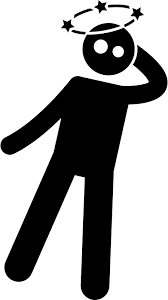Visual vertigo is a common symptom in patients with vestibular disease. It is not really an eye problem, but it is associated with vision so I hear about it from time to time. It is one of the major features of vestibular disorders such as Persistent Postural Perceptual Dizziness (PPPD - triple P D) I don't want to tackle the entire disorder, but I recommend some other websites that have more information like the vestibular disorders association.
I do want to focus on the visual aspect.
It is really important for your brain to keep track of where the head is located in space. This ties in to the eyes in two ways.
1 Every time your head moves, your eyes make a perfect counter roll to stay on target. This is called the vestibular ocular reflex. Your vestibular system senses the head motion and sends that information to the brain, then your brain calculates an eye movement to offset the head movement and stabilize the vision. I like to test this with head shaking visual acuity. The patient will read the eye chart normally, then I will ask them to read the eye chart while I (gently) jiggle their head side to side. If they can still read the same line or one line different, then I know they have intact vestibular ocular reflex.
2 The other important connection with balance and vision is that your brain uses various sensory inputs for balance. The number one sensation is your vestibular sense which comes from the inner ear. The number two input is vision. Your brain relies on vision to balance. We all know that it is harder to balance in the dark or with our eyes closed.
Visual vertigo is connected to this relationship between balance and vision.
Oftentimes patients with vestibular disease (fill in the blank) develop an over-reliance on their visual sensation to balance. Even if their vestibular disease has recovered, the brain may have learned an over-reliance on vision.
Vestibular sense is supposed to be number one and vision is supposed to be number two. If the brain switches the order of importance then some weird sensations can occur.
Visual vertigo is a sensation of motion that is not really happening and creates a sense of movement that is unpleasant. It feels kind of dizzy so the best term is visual vertigo.
Patients often describe difficulty with some or all of the following:
- Walking down grocery aisles and looking at all the packaging and overhead lights
- Driving through dappled shade and other flickering lights
- Watching action on large screen.
- Scrolling on computers, tablets and such
- Seeing running water, like a stream or raindrops on the windshield
- Crowds, where there is a lot of activity and expressive hand motions
- Busy patterns
And so forth...Essentially, what is happening is a mismatch between the visual and the vestibular. You may not be moving much, but there is such a visually active environment that it creates a confusion. If you are standing still but there is a lot of movement going on around you, the ears will tell the brain there is no movement. The eyes will tell the brain there is lots of movement and the brain should be able to figure it out. If the brain has become too reliant of vision for balancing, this creates a real illusion of movement and it is not fun.
If there is a vestibular disorder, then treating that is the first priority.
If the vestibular disorder is no longer an issue, then treatments are to retrain the brain to function with vestibular sensation. Vestibular therapy, which is a focus of physical therapy can work. Patients sometimes also benefit from antidepressants. This symptom is distressing, but I don't think that is the reason for the antidepressants. Some of those medications have brain effects that improve the ability to readapt.
Visual vertigo can be difficult to diagnose since it is mostly a subjective symptom, but it is a real component of vestibular disorders.
In summary, visual vertigo occurs if the brain develops a mismatch between the normal vestibular and visual inputs for balance. It is triggered by visually complex environments that create a form of movement illusion. It is unpleasant. It can be treated by retraining the brain. Vestibular therapy and anti-depressant medications are both effective. Visual vertigo can be difficult for others to appreciate, but it is real.








